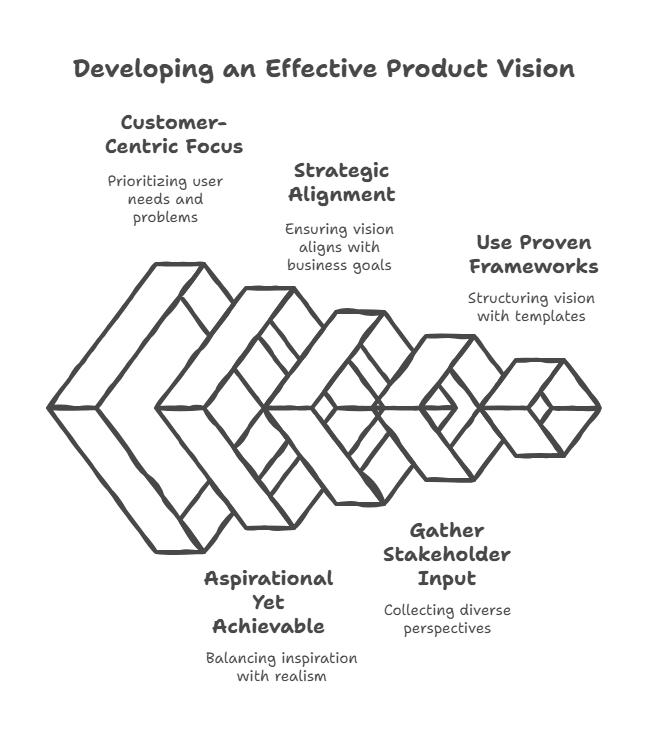What is a Product Vision Statement? Definition and Examples
Learn what a product vision statement is, why it matters for product teams, and how to create an inspiring vision that aligns stakeholders and drives innovation.
What is a Product Vision Statement?
A product vision statement describes the overarching long-term mission of your product. This aspirational declaration communicates where your product is headed and why it matters. Unlike detailed roadmaps or feature lists, a vision statement provides the strategic north star that guides all product decisions and inspires your team to work toward a common future.
Think of your product vision as the foundation that helps you create a forward-looking, customer-driven product strategy that keeps the future in focus. It answers fundamental questions about what problem you're solving, who you're serving, and what success looks like in the long term.
Why Product Vision Statements Matter
A well-crafted product vision statement delivers multiple strategic benefits that extend beyond simple direction-setting.
Alignment and Focus
A purposeful and aligned product vision statement ensures your product team works toward meaningful goals that integrate with company strategy. This alignment prevents feature creep and keeps everyone focused on what truly matters for long-term success. When teams understand the "why" behind their work, they make better daily decisions that support the broader vision.
Stakeholder Engagement
The Product Vision is owned by the Product Owner, but its development requires input from stakeholders and the Scrum Team. A clear vision becomes a transparent instrument that enables everyone to understand the product's intention and direction. This shared understanding reduces conflicts and creates buy-in across the organization.
Innovation Catalyst
When teams have a clear vision, they can use it as THE true north to guide the project. This clarity empowers teams to innovate within established boundaries, knowing their creative solutions will support the overall mission. A compelling vision inspires teams to do their best work by connecting their daily tasks to meaningful outcomes.
Key Components of an Effective Product Vision
While formats vary, most powerful product vision statements include several core elements that make them effective.

Customer-Centric Focus
A product vision statement that focuses on the customer ensures the product team always thinks about user needs first. Your vision should clearly articulate who you're serving and what problem you're solving for them. This customer-first approach prevents internal biases and keeps the product relevant to market needs.
Aspirational Yet Achievable
The best visions strike a balance between being inspirational enough to motivate teams and realistic enough to be credible. They paint a picture of an achievable future that's worth striving for, without being so vague that they provide no practical guidance.
Strategic Alignment
Your product vision must align with broader business goals and company mission. This ensures that product development contributes to organizational success rather than operating in isolation. The vision should demonstrate how the product supports the company's overall direction and values.
Creating Your Product Vision Statement
Developing a compelling product vision requires thoughtful consideration of multiple perspectives and strategic inputs.
Gather Stakeholder Input
Effective vision development involves gathering and integrating stakeholder input from customers, business executives, and development teams. This collaborative approach ensures the vision reflects diverse perspectives and builds organizational commitment. Regular feedback collection helps maintain alignment as market conditions evolve.
Use Proven Frameworks
Several templates can help structure your vision creation process. The Elevator Pitch approach encourages distilling your ideas into a simple sentence structure that captures the product's essence. Other frameworks like the Vision Board provide visual tools for developing strategy based on your product vision.
Avoid Common Pitfalls
Many organizations fall into the trap of predominantly focusing on product features when creating vision statements. Remember that your vision should describe outcomes and value, not specific functionalities. Keep it focused on the "what" and "why" rather than the "how" of implementation.
From Vision to Execution
Once established, your product vision becomes the foundation for all subsequent planning and decision-making. It informs your product strategy, guides roadmap prioritization, and helps evaluate new opportunities. Teams can reference the vision when facing difficult trade-offs or considering new features to ensure consistency with long-term goals.
For product managers and teams looking to visualize and communicate their product vision effectively, ClipMind offers tools that can help structure and share your strategic thinking. The platform's AI Outline Maker can help organize your vision components, while mind mapping capabilities make it easier to see how different elements connect to your core mission.
A well-crafted product vision statement transforms from words on paper to a living guide that shapes product development, inspires teams, and delivers meaningful value to customers and the business alike.
 ClipMind
ClipMind